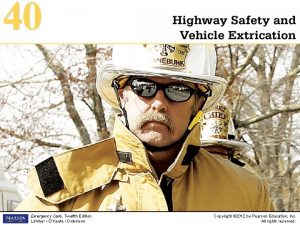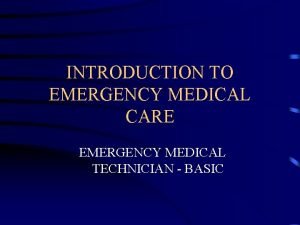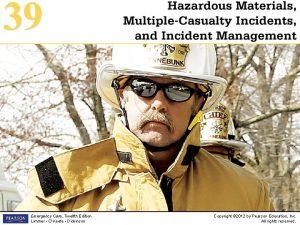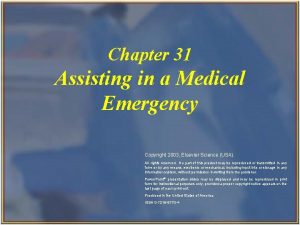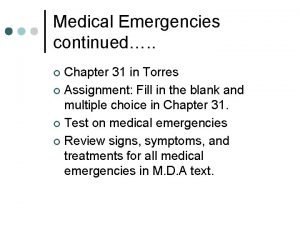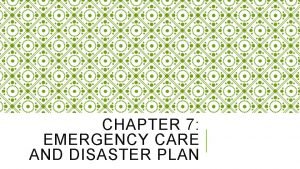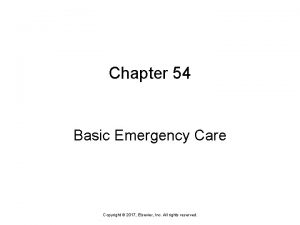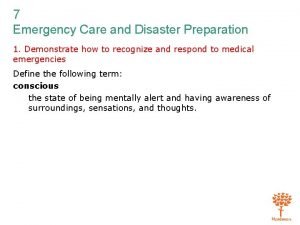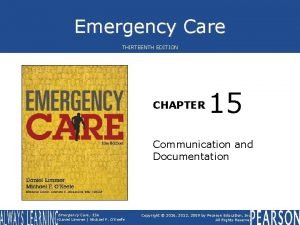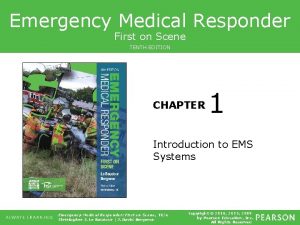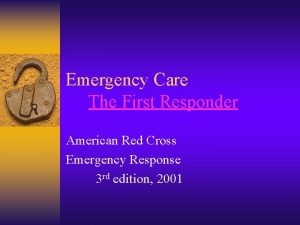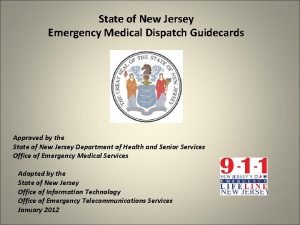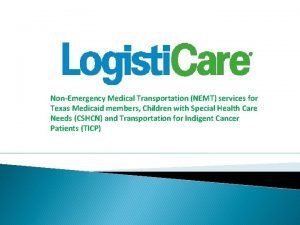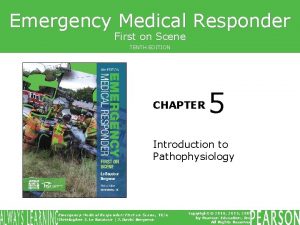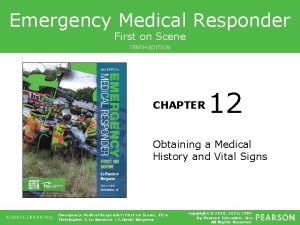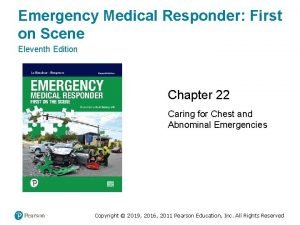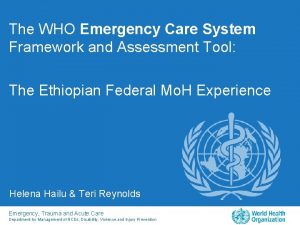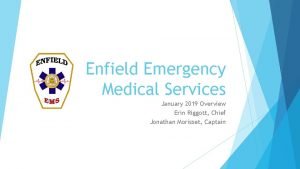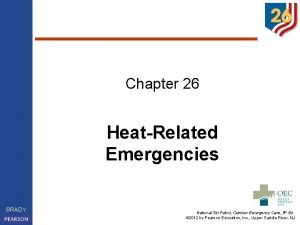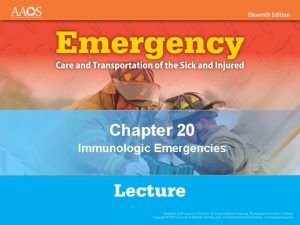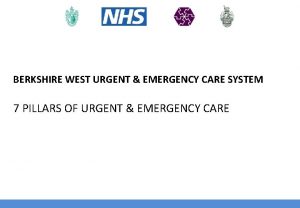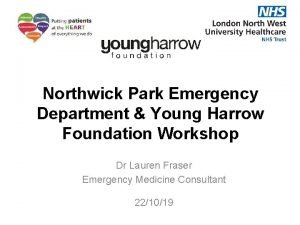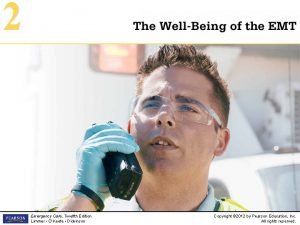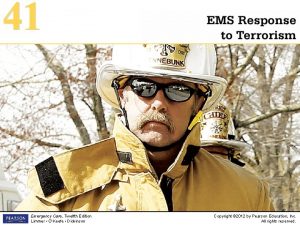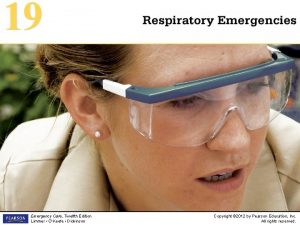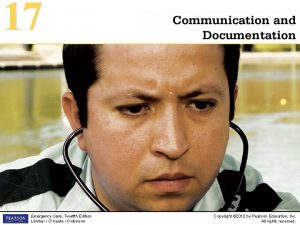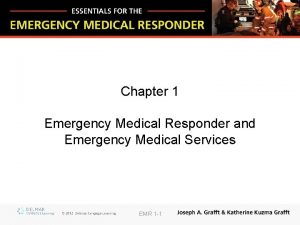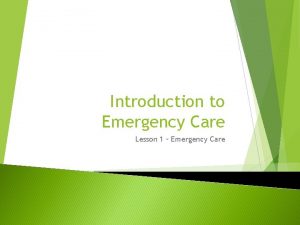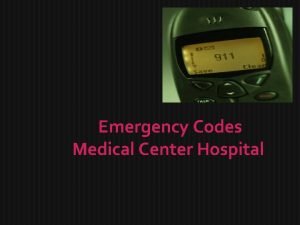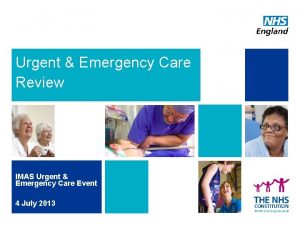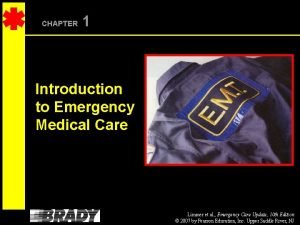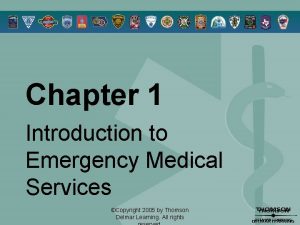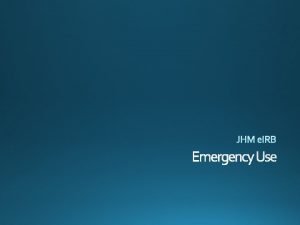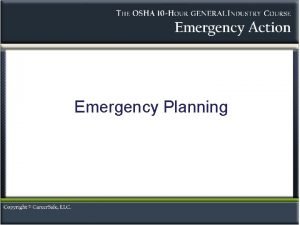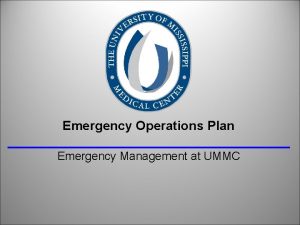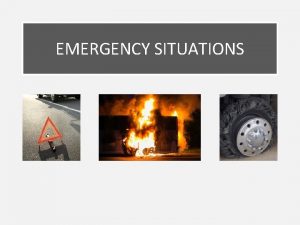Chapter 1 Introduction to Emergency Medical Care Copyright
































- Slides: 32

Chapter 1 Introduction to Emergency Medical Care Copyright © 2007, 2004, by Mosby, Inc. , an affiliate of Elsevier Inc. All rights reserved. Slide

Case History You respond to a call for a patient in cardiac arrest. On arrival, you find a 52 -year-old male who is pulseless and not breathing. A family member is performing CPR. The family states that he collapsed 4 minutes before your arrival. Copyright © 2007, 2004, by Mosby, Inc. , an affiliate of Elsevier Inc. All rights reserved. Slide 2

Historical Perspective Battlefields Lay the Foundation Napoleonic Wars – Ambulance volantes Civil War – Horse-drawn ambulances World War I – Motorized ambulances Copyright © 2007, 2004, by Mosby, Inc. , an affiliate of Elsevier Inc. All rights reserved. Slide 3

Historical Perspective Battlefields Lay the Foundation Korean War – Helicopters and MASH units Death rates from battle casualties 8% WW I Ø 4. 5% Korea Ø 2% Vietnam Ø Copyright © 2007, 2004, by Mosby, Inc. , an affiliate of Elsevier Inc. All rights reserved. Slide 4

Historical Perspective Civilian Evolution • Civilian evolution varied from region to region in U. S. • Rural areas – Undertakers Ø Fire departments and volunteer ambulance replaced funeral directors • Urban areas Ø Hospital-based Ø Fire departments Ø Police departments Ø Independent ambulance companies Copyright © 2007, 2004, by Mosby, Inc. , an affiliate of Elsevier Inc. All rights reserved. Slide 5

Historical Perspective Civilian Evolution • Mid-1860 s – First hospital-based ambulance services Ø Cincinnati General and Bellevue Hospitals • 1899 – The first motorized ambulance Ø Michael Reese Hospital of Chicago Copyright © 2007, 2004, by Mosby, Inc. , an affiliate of Elsevier Inc. All rights reserved. Slide 6

Trauma as an Impetus for EMS Development • Preventable injury Ø Leading cause of death in ages 1 to 45 • Automobile caused surge in trauma deaths Ø 1900 – 7 th leading cause of death Ø 2000 – 4 th leading cause of death Ø Automobiles account for 50% Copyright © 2007, 2004, by Mosby, Inc. , an affiliate of Elsevier Inc. All rights reserved. Slide 7

Knowledge and Technology • 1960 – CPR developed • 1960 s – Portable defibrillators • First ALS units Ø Belfast, Ireland Ø St. Vincent’s Hospital (New York City) Ø Only physicians provided advanced care Copyright © 2007, 2004, by Mosby, Inc. , an affiliate of Elsevier Inc. All rights reserved. Slide 8

Knowledge and Technology • Late 1960 s – Biotelemetry developed • Allowed EMS providers to deliver ALS Ø Defibrillation Ø Advanced airway procedures Ø Drug therapy • “Johnny and Roy” popularized paramedics on TV show Emergency! Copyright © 2007, 2004, by Mosby, Inc. , an affiliate of Elsevier Inc. All rights reserved. Slide 9

The Physician and EMS • Physician societies organized early EMS programs Ø American Academy of Orthopaedic Surgeons (AAOS) Ø American College of Surgeons (ACS) • Worked with National Highway and Traffic Safety Administration (NHTSA) Copyright © 2007, 2004, by Mosby, Inc. , an affiliate of Elsevier Inc. All rights reserved. Slide 10

The Physician and EMS • Physician groups still involved ØAmerican College of Emergency Physicians (ACEP) ØNational Association of EMS Physicians (NAEMSP) ØNational Association of State EMS Medical Directors (NAEMSD) Copyright © 2007, 2004, by Mosby, Inc. , an affiliate of Elsevier Inc. All rights reserved. Slide 11

The Landmark Paper – 1966 “Accidental Death and Disability: The Neglected Disease of Modern Society” Ø Prompted federal money to develop EMS in 1973 Ø “Provide safe handling and transportation of ill or injured. ” Provided impetus for rapid proliferation Copyright © 2007, 2004, by Mosby, Inc. , an affiliate of Elsevier Inc. All rights reserved. Slide 12

EMS Agenda for the Future: 14 Components 1. 2. 3. 4. 5. 6. 7. Integration of health services EMS research Legislation and regulation System finance Human resources Medical direction Education systems 8. 9. 10. 11. 12. 13. 14. Public education Prevention Public access Communication systems Clinical care Information systems Evaluation Copyright © 2007, 2004, by Mosby, Inc. , an affiliate of Elsevier Inc. All rights reserved. Slide 13

Elements of a Communications System The dispatch system – Enhanced 911 Formal national program to train dispatchers Ø Emergency Medical Dispatch (EMD) Ambulance-to-hospital Radio Ø Cell phone Ø Landline Ø Copyright © 2007, 2004, by Mosby, Inc. , an affiliate of Elsevier Inc. All rights reserved. Slide 14

Levels of Training Lay rescuer First responder EMT-Basic EMT-Intermediate EMT-Paramedic Copyright © 2007, 2004, by Mosby, Inc. , an affiliate of Elsevier Inc. All rights reserved. Slide 15

Lay Rescuer Carry little or no equipment Recognize life-threatening illness or injuries Provide lifesaving care until EMS arrives CPR Ø Relief of airway obstruction Ø Use of an AED Ø Bleeding control Ø Copyright © 2007, 2004, by Mosby, Inc. , an affiliate of Elsevier Inc. All rights reserved. Slide 16

First Responders Equipped with Oxygen Ø AEDs Ø Airway equipment Ø Provide lifesaving care until EMS arrives Copyright © 2007, 2004, by Mosby, Inc. , an affiliate of Elsevier Inc. All rights reserved. Slide 17

EMT-Basic Provide basic, noninvasive skills Ø Ø Ø Ø Patient assessment CPR Airway adjuncts AED use Childbirth Splinting Spinal immobilization Administration and assistance with medications • Activated charcoal, metered-dose inhaler, nitroglycerin, epinephrine Ø Use variety of transport devices Copyright © 2007, 2004, by Mosby, Inc. , an affiliate of Elsevier Inc. All rights reserved. Slide 18

EMT-Intermediate Provide same skills as EMT-B Provide additional advanced skills, including Ø Ø Advanced airway techniques ECG recognition Intravenous fluid therapy Administration of multiple medications Copyright © 2007, 2004, by Mosby, Inc. , an affiliate of Elsevier Inc. All rights reserved. Slide 19

EMT-Paramedic Expanded scope of practice beyond EMT-B and EMT-I Provides advanced techniques, such as ECG interpretation Ø Drug therapy Ø Invasive airway techniques Ø Defibrillation Ø Often have more standing orders in protocols than EMT-I Copyright © 2007, 2004, by Mosby, Inc. , an affiliate of Elsevier Inc. All rights reserved. Slide 20

Chain of Survival Early Access Early CPR Early Defibrillation Early Advanced Care Copyright © 2007, 2004, by Mosby, Inc. , an affiliate of Elsevier Inc. All rights reserved. Slide 21

The Health Care System Emergency departments Specialty referral centers Hospital personnel Copyright © 2007, 2004, by Mosby, Inc. , an affiliate of Elsevier Inc. All rights reserved. Slide 22

Liaison with Other Public Safety Workers Conflicts may occur when overlaps with other public safety personnel Ø Ø Ø Police take charge at crime scene, traffic and crowd control issues Fire take charge at fire scene EMS responsible for patient care Cooperation is essential Incident command system should be in place Copyright © 2007, 2004, by Mosby, Inc. , an affiliate of Elsevier Inc. All rights reserved. Slide 23

Professional Attributes Demonstrate skill and knowledge for the good of the patient Promote high standards of behavior Add to your body of knowledge to continue to advance in the profession Copyright © 2007, 2004, by Mosby, Inc. , an affiliate of Elsevier Inc. All rights reserved. Slide 24

Professional Attributes Appearance Ø A professional appearance and attitude help evoke a sense of confidence in patients and family members. • Clean and appropriate clothing Ø Attitude more important than outer appearance • Show an interest in your job • Possess a sensitive awareness of environment and needs others • Putting patient/family needs ahead of your own will protect and preserve safety Copyright © 2007, 2004, by Mosby, Inc. , an affiliate of Elsevier Inc. All rights reserved. Slide 25

EMT-Basic Primary Responsibilities Patient assessment Personal safety and safety of others Patient care Lifting and moving patients safely Transport/transfer of care Copyright © 2007, 2004, by Mosby, Inc. , an affiliate of Elsevier Inc. All rights reserved. Slide 26

Other Responsibilities Record keeping Patient advocacy Extrication Communications Vehicle and equipment maintenance Copyright © 2007, 2004, by Mosby, Inc. , an affiliate of Elsevier Inc. All rights reserved. Slide 27

Local, State, and National Issues National Registry of Emergency Medical Technicians National Association of Emergency Medical Technicians The American Heart Association Continuing education Refresher courses Record keeping/Data Collection Copyright © 2007, 2004, by Mosby, Inc. , an affiliate of Elsevier Inc. All rights reserved. Slide 28

Quality Improvement: Definition A system of internal/external reviews and audits of all aspects of an emergency medical services system that identifies aspects that need improvement to ensure that the public receives the highest quality of prehospital care Copyright © 2007, 2004, by Mosby, Inc. , an affiliate of Elsevier Inc. All rights reserved. Slide 29

Role of the EMT-Basic in Quality Improvement Documentation Run reviews and audits Gathering feedback from patients/hospital staff Conducting preventive maintenance Continuing education Skills maintenance Copyright © 2007, 2004, by Mosby, Inc. , an affiliate of Elsevier Inc. All rights reserved. Slide 30

Medical Direction Accountability for the medical conduct of EMS personnel by a physician knowledgeable in patient care Online medical direction Ø Direct real-time contact via telephone or radio Offline medical direction Ø Written protocols, policies, procedures Copyright © 2007, 2004, by Mosby, Inc. , an affiliate of Elsevier Inc. All rights reserved. Slide 31

Summary EMT-Basic plays a key role in EMS system Teamwork with other providers is essential for effective patient care Quality assurance is an important role of the EMT-Basic Copyright © 2007, 2004, by Mosby, Inc. , an affiliate of Elsevier Inc. All rights reserved. Slide 32
 Introduction to emergency medical care
Introduction to emergency medical care Introduction to emergency medical care
Introduction to emergency medical care Medical
Medical Introduction to emergency medical care
Introduction to emergency medical care Chapter 31 assisting in a medical emergency
Chapter 31 assisting in a medical emergency Define medical emergency chapter 31
Define medical emergency chapter 31 Emergency care and disaster preparation chapter 7
Emergency care and disaster preparation chapter 7 Chapter 54 basic emergency care
Chapter 54 basic emergency care Emergency care first aid and disasters
Emergency care first aid and disasters Emergency care and disaster preparation chapter 7
Emergency care and disaster preparation chapter 7 Prehospital care 11th edition
Prehospital care 11th edition Emergency care 13th edition chapter 1
Emergency care 13th edition chapter 1 Primary secondary tertiary medical care
Primary secondary tertiary medical care Emergency medical responder first on scene
Emergency medical responder first on scene Emergency medical responder red cross
Emergency medical responder red cross Medical emergency student lectures
Medical emergency student lectures Nj emd guidecards
Nj emd guidecards Nonemergency medical transportation
Nonemergency medical transportation Cardiopulmonary
Cardiopulmonary Brachial pulse location
Brachial pulse location Emergency medical responder first on scene 11th edition
Emergency medical responder first on scene 11th edition Who emergency care system framework
Who emergency care system framework Prehospital emergency care 10th edition
Prehospital emergency care 10th edition Therapeutic communication techniques
Therapeutic communication techniques Pa wc bureau
Pa wc bureau Emergency care enfield
Emergency care enfield Outdoor emergency care 6th edition
Outdoor emergency care 6th edition Care for a victim of an immunologic emergency
Care for a victim of an immunologic emergency Emergency care newbury
Emergency care newbury Prehospital emergency care 11th edition
Prehospital emergency care 11th edition Prehospital emergency care 11th edition
Prehospital emergency care 11th edition Golden rules of emergency care
Golden rules of emergency care Northwick park emergency department
Northwick park emergency department
